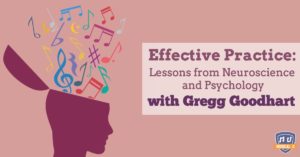We musicians are all too familiar with the restless drive to grow and learn. No sooner have we conquered one song, one skill then we’re on to the next – always striving for that mastery.
But what if that mastery stubbornly eludes us?
Think you’ll escape by quitting music? Musical U’s Adam Liette is case-in-point that once you are a musician, you are always a musician. And that’s a good thing!
And what about that Locrian metal riff, crazy recorder cross-fingering, or high vocal note that always seem just beyond your reach? Gregg Goodhart, aka The Learning Coach, has combined neuroscience, psychology, and years of hands-on experience to help you achieve amazing results from your practicing that you never thought possible.
There’s nothing like a new scale to open your ears and hands up to new sonic possibilities. And sometimes, it’s best to just kick back and relax (relish it – it won’t last long!) with some sultry Latin pop.
Always a Musician
 The Musical U team is packed with musical drive and experience. Our Communications Manager Adam Liette is no exception. A heavy metal guitarist and former Army trumpeter, Adam discovered his love for country music while playing guitar in a touring military band in Afghanistan.
The Musical U team is packed with musical drive and experience. Our Communications Manager Adam Liette is no exception. A heavy metal guitarist and former Army trumpeter, Adam discovered his love for country music while playing guitar in a touring military band in Afghanistan.
Though his military and business careers have put performing music on the back burner, Adam brings the same love of learning and growing to his teamwork at Musical U where he runs our social media, promoting our new articles each week on Facebook, Twitter, YouTube and more.
“I like to think that we are not just helping people learn music, but helping them achieve a fuller, more complete life!” – Adam Liette
Adam also reaches out to other music educators and amazing musicians with similar missions, providing our audience with a steady stream of fascinating guest posts and interviews. We enjoyed getting to know Adam a little better in this interview, and know you will too when you Meet the Team: Adam Liette.
Dorian Demystified
Learning new scales can really open up your musical awareness and ability.
Wait. You’ve twisted your fingers around your 15 major and 15 minor scales (45 if you count natural, harmonic and melodic minors!). Isn’t that enough?!
The coolest thing about the Dorian mode – apart from an intense, driving sound that makes it one of the most popular minor scales in jazz, R&B, metal, many rock and pop songs, and traditional Celtic music – is that you already know it!
How can that be? Learn more about this Minor Scale With A Bright Spot: The Dorian Mode
Learning modes will open your ears to a whole new level of harmonic and melodic colors. Fretello breaks down this misunderstood (and often intimidating) topic of modes into something that will be easy to grasp. Get ready to jump on the modal bandwagon!
The Dorian mode is very popular for constructing guitar solos and creating some fantastic melodies. Getting started on the mode can be difficult, especially when trying to connect various scale shapes on the fretboard. Spy Tunes provides a super series of videos on beginning to use Dorian in your guitar playing.
Modes do not just impact the melody, but the entire harmonic structure of a piece of music. Incorporating the unique color of Dorian into the chord progression behind a melody will add so much to your music. Check out this exploration to see the chords and scales that fit within the B Dorian harmony.
While it is popular with guitar players, Dorian can be applied to any and all musical instruments. This lesson from Sean Wilson Piano shows how to practice the Dorian scale on the keyboard, and has some great information for all instruments on which chords to use when playing in Dorian.
The Learning Coach
 When he became a classical guitar teacher in a public school, Gregg Goodhart was driven to help his students maximize their potential – and move beyond it! Through applying the lessons of modern neuroscience and psychology, he has developed systems that raise the bar on learning across every discipline.
When he became a classical guitar teacher in a public school, Gregg Goodhart was driven to help his students maximize their potential – and move beyond it! Through applying the lessons of modern neuroscience and psychology, he has developed systems that raise the bar on learning across every discipline.
Last time we spoke with Gregg, he explained this new paradigm of confidence and peak performance. This time Gregg shows how applying the lessons of learning science can actually cause us to acquire the “talent” we thought was out of reach.
Learn how you can do it for yourself with Effective Practice: Lessons from Neuroscience and Psychology, with Gregg Goodhart.
Practice sessions, and how the musicians approach their practice, can be the difference-maker in developing your capabilities as a musician. As times and technology have changed, it has become both more complex and easier to track your daily practice. Jason Heath of Contrabass Conversations talks about the evolution of his practice routine and how to use new tools for keeping yourself on the right path.
Many of us have been taught to practice the way that we would perform a piece of music. Shouldn’t our practice be organized in a similar manner? Better Practice App talks about how to organize your practice into set lists to make more efficient use of time and better prepare for a performance or lesson.
Yes, practice can be… boring. And who actually likes playing scales?
We understand! Some of the things that we need to do to become more proficient on our instruments aren’t always fun. But, what if you can find ways to make your practice more musical? Check out this video from Sean Daniel Music on how to implement little tips that will make practice more enjoyable.
We are all so busy trying to manage our lives and maintain our daily practice routines! So, we need to be as efficient as possible when we finally get the chance to work on music. Samurai Guitarist talks about some strategies that you can implement immediately to improve your daily practice:
Get Your Swoon On
 Sometimes every musician can benefit from a vacation. But that’s not always in the budget, is it? Here’s the next best thing: kick back and listen to a new genre from a different part of the world.
Sometimes every musician can benefit from a vacation. But that’s not always in the budget, is it? Here’s the next best thing: kick back and listen to a new genre from a different part of the world.
A few weeks ago, we opened your ears to traditional Latin music and rhythms. Now see what happens when Latin rhythm meets pop stardom and captivates audiences worldwide: Open Your Ears to Latin Pop.
Latin pop music has distinct rhythmic qualities that set it apart from other genres of music. Naturally, this requires the percussionist to work at particular skills and competencies in order to drive the rest of the band. How is one to get started on the various types of rhythm incorporated in Latin music? Check out this page from Online Drummer with links to various types of Latin rhythms.
Latin music has inspired musicians from many different genres! This includes jazz musicians, who have infused the elements of Latin music into their charts for a celebration of musical styles that must be experienced by every musician. Jazz Education Network shows how to incorporate Latin percussion elements in jazz band.
With so much music out there to inspire your next creation, how can you take the style of Latin Pop Music and apply it to your instrument? Easy Piano Styles lays out the basics of how to play Latin rhythms on the piano. Have fun incorporating this into your repertoire!
As Latin Pop Music has continued to gain a greater following, the style has been blended with many other styles of music to create unique new blends of music. Creative Guitar Studios shows how to incorporate the sound of Latin pop music into jazz, to create a fusion that is truly fun to hear and play!
Well, I see that vacation didn’t last long! As soon as you heard those irresistible Latin rhythms, you were off figuring out how to add them to your musical toolbox. Learning, improving, creating more wonderful music – it’s what we do! So dive into Dorian, learn how to learn better, and remember the lesson from our own Adam Liette: once a musician, always a musician.
The post Effective Practice, Meet Adam, Dorian Mode, and Latin Pop appeared first on Musical U.